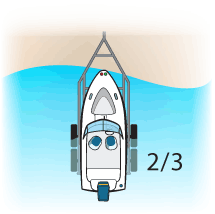Launching & Retrieving Boats
Here are some steps to ensure that you have a smooth experience at the boat launch. The first step is to get your boat ready away from the launch area itself. This will make sure that you aren't blocking any other boaters who are waiting to use the launch—keeping everybody happy.

Some of the steps you can take care of before approaching the ramp include:
-
Removing all the tie-downs, with the exception of the winch line.

- Loading any additional supplies and equipment into the boat;
- Inserting the drain plug; Disconnecting the trailer's brake lights – so you don't burn out any bulbs;
- Removing the motor travel supports, if used; and
- Putting the trim up to prevent hitting the prop when launching.

If you're launching the boat by yourself, you can attach a line to the bow to steady the boat upon its release. If you have two persons launching the boat, and one is staying in the boat, you may not need a bow line.
Prepare your boat away from the ramp to avoid creating unnecessary delays at the launch area.
Launching your Boat
Now that you're ready for launch, approach the boat ramp and back the trailer into the water.
Go far enough so that your trailer tires are in the water but not the axle bearings. The cooling water intake holes on the lower unit of the engine should be submerged.
At this point, apply the parking brake on your towing vehicle. If at all possible, you want to keep the wheels of your towing vehicle out of the water.
Now, gradually release the winch line and slowly reverse the boat off of the trailer and into the water.
Once in the water, secure the boat to the dock and promptly move your vehicle and trailer away from the launch. This will avoid blocking any boaters waiting to use the launch.
If you anticipate any kind of engine problems, it's a good idea to start the engine and let it warm up while your boat is still attached to the winch line, and before reversing the boat off of the trailer. If your engine doesn't start, it's a lot easier to retrieve your boat if it is still on the trailer.
Remember to follow good boating etiquette by preparing your boat away from the launch area to prevent unnecessary delays for other boaters.
Retrieving a Boat
When it's time to retrieve your boat, it's a great idea to have someone at the boat launch to 'spot' for you. This is especially important if you are dealing with a steep boat ramp.
Both you and your spotter should be keeping an eye out for any pedestrians or other boats in the area.
Get your towing vehicle and trailer ready and then wait for your turn.
Remember, like when launching your boat, the proper etiquette is to unload all your extra fuel and equipment away from the launch, so as not to delay other boaters.

When it's your turn to retrieve your boat, back your trailer into the water until two-thirds of its bunks or rollers are submerged. Like launching your boat, you should keep your towing vehicle's wheels out of the water unless absolutely necessary.
Next, attach a bow line to the boat in order to steady the retrieval process.
Now maneuver or cautiously drive your boat close enough to attach the winch line.
Once the winch line is attached, shut off the engine and tilt the engine up.
Crank the winch line to pull the boat up the trailer. Stay out of the direct path of the winch line in case it breaks.
Once your boat is well secured, tow your trailer out of the water and away from the boat ramp; out of the way of others.
Now it's time to begin your preparation for the road. Remember to remove your drain plug, pump or drain any water out of the bilge, and drain the live-wells or bait-wells if you have them.
To stop the spread of aquatic species, it's also important that you clean your boat before you leave the ramp area. Some states have specific requirements that must be followed to stop the spread of aquatic species, so check the regulations in the state where you are boating. As a rule, you should always remove all plant materials from your boat.

Always remember, you have another vehicle attached behind you. That means you need to take corners at slower speeds and at wider angles to make sure your trailer can get around safely.
Unload fuel and equipment away from the ramp whenever possible.
